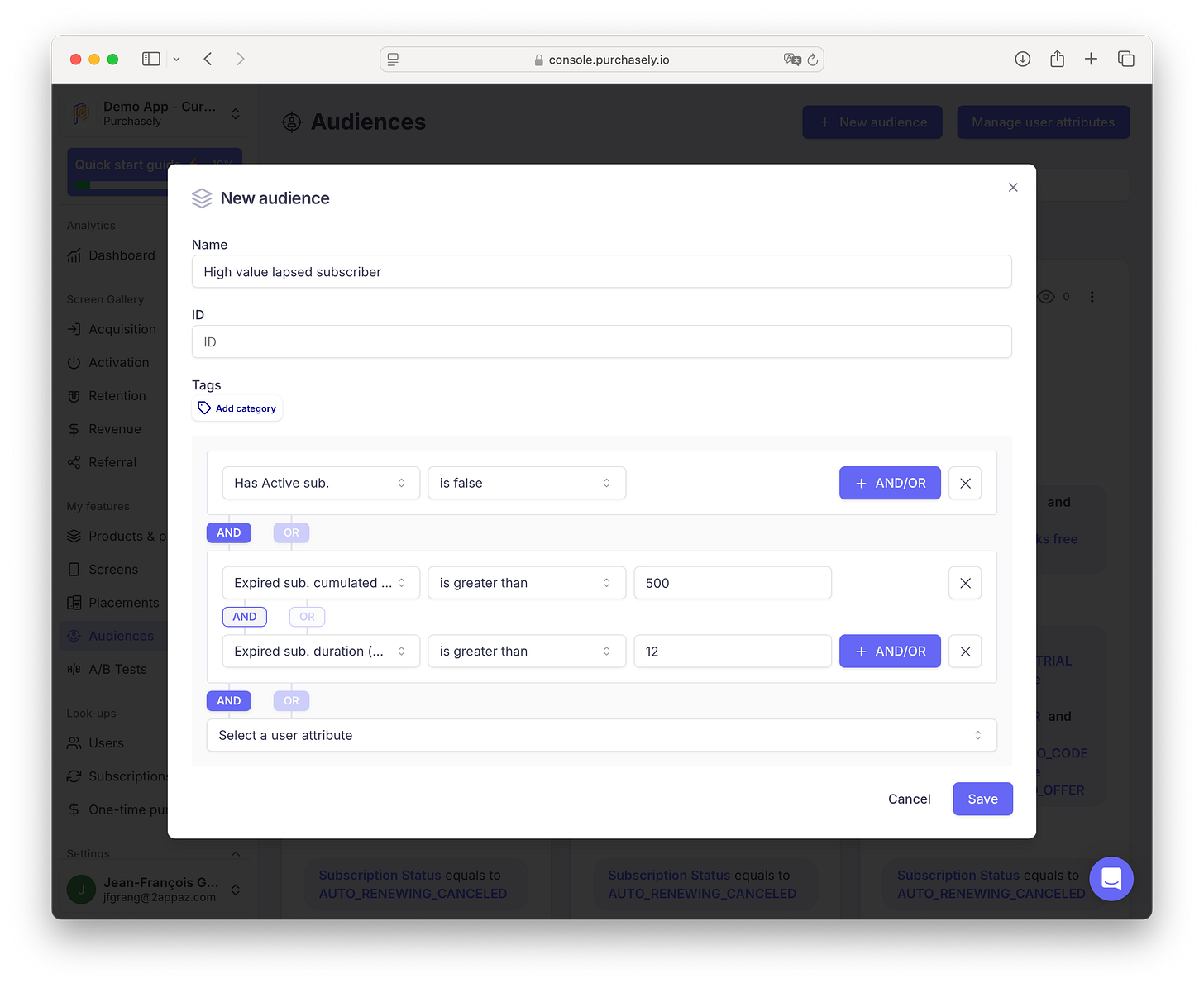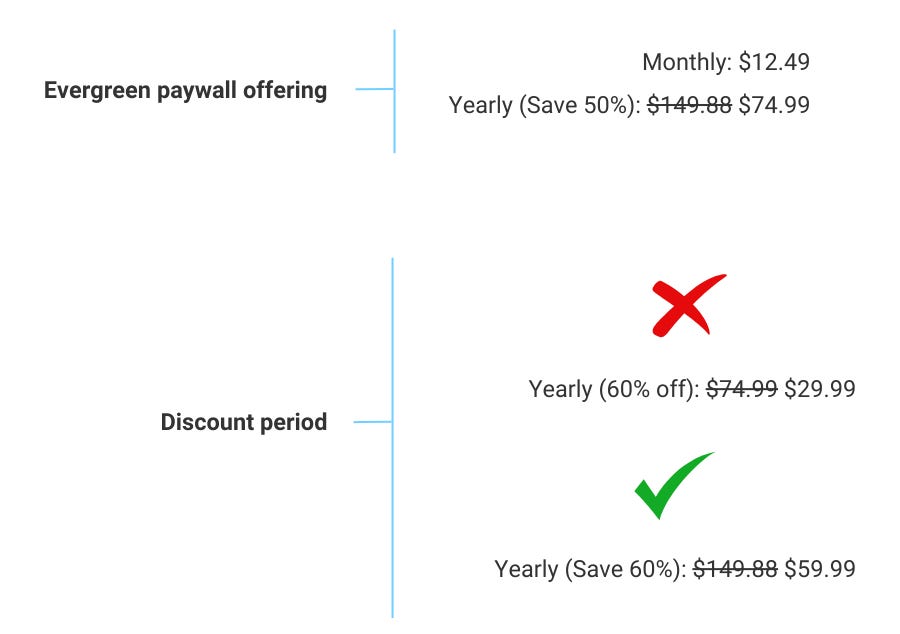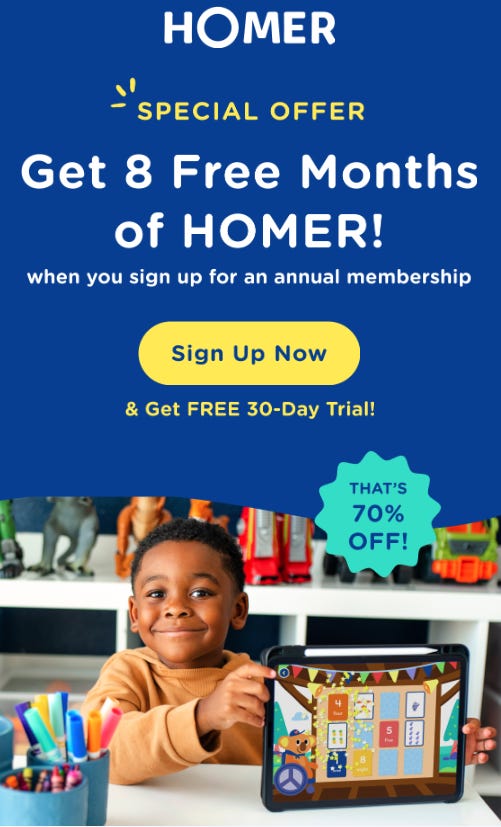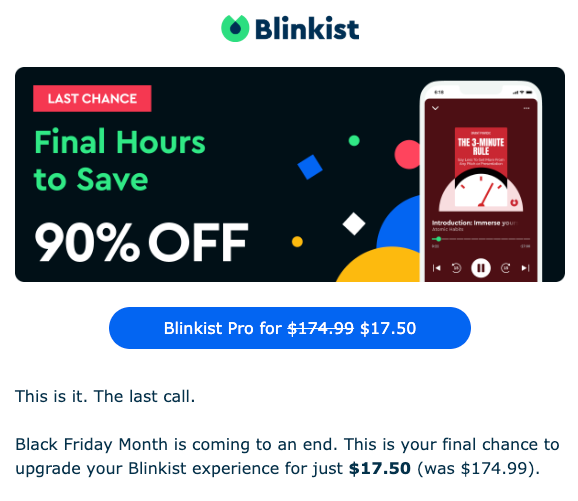💎 Discounting subscriptions: 14 tactics to mitigate the downsides (and maximize revenue)
Several tactics to mitigate the downsides if you're already discounting your subscription app or decide to do so.
Last week, I shared my (schizophrenic) analysis of discounting for subscription apps along with a decision matrix to help you know if you should prioritize this initiative. Click below if you haven’t read it yet👇
This week, I’m detailing the tips & tactics you can test in order to mitigate the cons of discounting subscription and maximize the impact.
The gem below from Phil Carter gives you a good high-level view.
💎 Promotions are a tool to better align the value of your product with the willingness to pay of an individual customer so you can capture more consumer surplus. You have to be targeted and thoughtful about promotions. The companies that are doing this best:
Interject their brand and personality into seasonal promotions to stand out
Use activity-based discounts (e.g., offer a discount after the point where 90% of subscribers typically convert)
Segment based on demographics/psychographics to better align the price of your product with the customer
(1:22:30) by Phil Carter in The Subscription Value Loop: A Formula for Growth
Use discounts “as a scalpel and not a blunt instrument”.
Let’s get into more detail!
1. Start with the data
I love what Vahe recommends in this article.
Look at your current conversion rate data, so you can figure out after how much time a cohort barely converts anymore.
Pro Tip: don’t forget to look into this for different periods of the year.
🤝 FRIENDS OF GROWTH GEMS
Speaking of Vahe, he recently launched paywalls.design.
The concept? Risk-free paywall designs.
I even got you an offer to make this an absolute no-brainer!
2. Segment based on estimated willingness to pay
Broad discounts ignore regional and OS pricing sensitivity.
Along with discount guardrails (keep reading), you can also limit who gets offered a discount.
No need to go full geo-fenced discount: you can easily offer bigger discount in more price-sensitive territories and no discount or smaller discounts in territories with high willingness to pay.
You can also combine this with iOS vs. Android, or more granularly based on OS version.
For new users, gradually offering better discounts over time is a lower-effort approach to try and match willingness to pay.
For churned subscribers, I’ve also seen companies look at the revenue generated by the subscriber so far to adapt the discount. You can do this with Purchasely for example:
3. Simplify by discounting early
One of the main reasons not to discount is the distraction from focusing on what matters more and can be more impactful long-term.
If you limit your discounting to in-product and place this early on in the journey, effort is minimal and you can move on to other initiatives.
4. Have a holdout group or A/B test
Wouldn’t it be nice to understand the real impact of discounting?
This gives you the possibility to define a holdout group that will never see any offer, whether in-product or via lifecycle marketing. Over time, you can see how the LTV for the holdout group compares and decide if it’s all worth it.
💎 To understand the impact of your CRM initiatives:
Focus on impact per lifecycle stage (e.g., onboarding, activation)
Run a holdout group for X weeks
(09:45) by Karan Tibdewal in How Lifesum 2x'd Their Impact on M1 Retention by CRM: Case Study
A more punctual way to assess the impact is to run an A/B test. However, make sure to monitor these cohorts closely (particularly for churn when comes renewals) and look back at the results with a long-term conversion window.
I don’t like this as much as a holdout group because once you’ve ran more than one A/B test then things get messy (i.e., you can’t know who has never seen a discount). Regardless, this all goes away the minute you start advertising discounts via ads.
5. Test “renewal at full price” vs. “renewal at discounted price” (i.e., forever discounts)
Do you know what would yield the highest LTV (e.g., 2-year or 3-year) between discounting only the first period and also discounting renewals?
There are cases (like the one Flo describes here - thanks Ekaterina!) where a forever discount could actually bring in better LTV than someone purchasing at full price, because users get pleasantly surprised.
It also means you can leverage it in your initial discount messaging…
…or even when users try to cancel (not exactly what Canva did top-left below but you get the idea).
I’ve also seen A/B test results where renewing at full price brought more revenue, so you’ll have to test yourself. Plant the seed now, since it takes time.
My current thinking on this: if the actual discount is small, renewal at full price is more likely to win, because subscribers have now experienced the value and won’t be as sensitive to an additional $20/year. But if you got them in with a huge discount and they see a full price renewal, it’s unlikely they will (you might even have an additional support ticket and/or app store review).
🤝 FRIENDS OF GROWTH GEMS
Tired of commenting on LinkedIn posts to “get 300 onboarding screenshots”? 😂
More seriously, I’ve tried a few different “onboarding & paywall” tools the last few years. They usually fall short.
Here’s what I love about screensdesign:
They include video recordings (some interactions are key!)
You can filter by installs, revenue, or revenue per install (to find the ones that monetize the best - you’re welcome)
And guess what? I also got you a sweet offer :)
6. Frame discounts/savings correctly
On their paywall, most apps frame the savings users get for the annual plan based on your monthly plan (i.e., comparing the “per month” price of both).
Monthly: $12.49
Yearly “Save 50%”: $149.88 $74.99
Too often, though, when they start discounting, they do “hard” discounts. Essentially, they’re slashing prices when they just need to discount a bit to show great savings.
The end price does matter to customers (to some extent), but so do the savings shown in communications and on the price page or paywall.
How do you know you’re on the right path? You should see higher conversions AND higher ARPPU.
A little tip worth trying 👇
💎 Try offering very specific numbers for your discounts, so that your offer can stand out. Example: Calm offers 31% off to some users that have canceled the free trial.
(12:15) by Rosie Hoggmascall in App Monetization Masterclass
There’s another way to frame these savings that is a bit more in the “grey area” of tactics: mentioning that users are getting “free months”.
7. Create urgency
When discounting, use limited-time offers for discounts in order to create a sense of urgency.
In-product, it can look like the badge you see at the bottom left below:

Here’s a sequence I’ve seen work via CRM:
First email where you indicate a deadline a few days later
Second email 24 hours before the deadline
(Optional) Last email a few hours before the deadline
8. Set guardrails
Based on your current ARPPU during low and peak seasons, you need to define what is too low of a price.
I don’t have a number for you.
I just know when it feels too low, particularly when it’s targeted at everybody on your email list (I’m not sure this was the case below)…
Another guardrail I recommend: making sure there is no better offer than what you might share via lifecycle/email (⚠️ this includes offers from affiliates).
9. Introduce a promo-only longer plan
Needless to say (?), you need to discount your longest plan duration(s) only.
Taking this a little further, keeping in mind the goal to get higher conversions AND higher ARPPU, something you should test is to introduce a longer plan only during promo periods.
It can be lifetime (Should you add a lifetime plan?), but a safer bet is something like a 2-year plan or a family plan.
10. Run only highly relevant seasonal discounts…
Based on the target country and your app’s category, it’s most likely that some periods are more relevant than other, making a (limited-time) discount more natural.
Some obvious examples:
New Year for fitness and education
Back-to-school for education

If you have a Google Play contact, ask them for a country-specific calendar and select the events that align the best with your value proposition (like the one below I shared in Growth Gems #106).
If you don’t have such a contact, LLMs also work (cf. the example earlier in this post).
11…And/or discounts during off-peak conversion windows!
Once you’ve identified your low and peak seasons, you can also test discounting when full-price conversions dip naturally. Essentially, you’re making your own season (like we have Q5 for paid acquisition 😂).
Examples:
A streaming app discounting every April (a historically low sign-up month)
A fitness app discounting in December
12. Gamify it / Make users earn it
Some apps add a little fun before displaying an offer, with some “spin-the-wheel” tactics.
This is something Endel does with their “shake the tree”:
It’s even better if you can align this with your app’s concept, like Calm does with the meditation bowl.
Tell me you wouldn’t engage with an app you’re interested in if you only had until midnight to try it for free…A great offer to provide, especially if you don’t have a free trial.
13. Send traffic to web payments
If we’re talking about email offers, then sending traffic to a web purchase will save you some store fees.
This usually doesn’t justify getting set up with web payments in itself, but if you are already set up it makes it easier to offer a discounted price and/or unique offers that the app stores don’t provide.
14. Use a “trial or subscribe” event
If your default paywall has a free trial but not your discounted offer, and you want to make sure you don’t decrease the signal sent back to ad networks like Meta (cf. my point here), you can set up a trial_or_purchase event.
It does increase complexity of course, particularly if you’re already using your free trial event in a bunch of places (Meta campaigns, third-party tools, etc.).
I hope this helps you decide what to prioritize for maximum impact.
Stay curious!
— Sylvain
Chief Insights Miner at Growth Gems ⛏️
(Fractional) Head of Growth at Reading.com
Growth Consultant/Advisor for high-potential subscription apps (hit reply if you want to chat - bonus if you’re in Education, Meditation & Cooking categories)
Acknowledgments 🙏
Huge thanks to Thomas Petit, Kurtis Morrison, and Ekaterina Gamsriegler for their feedback on this edition.















